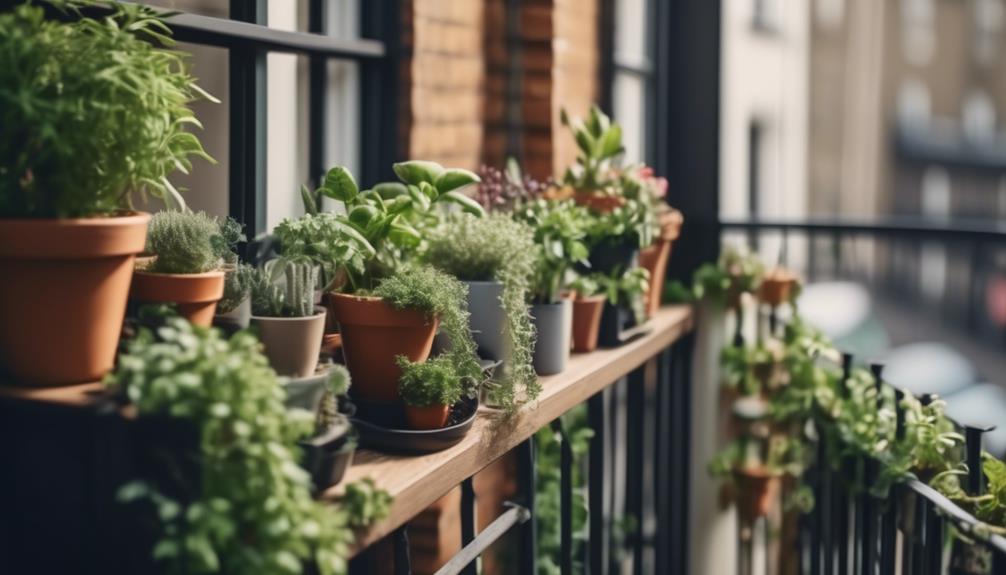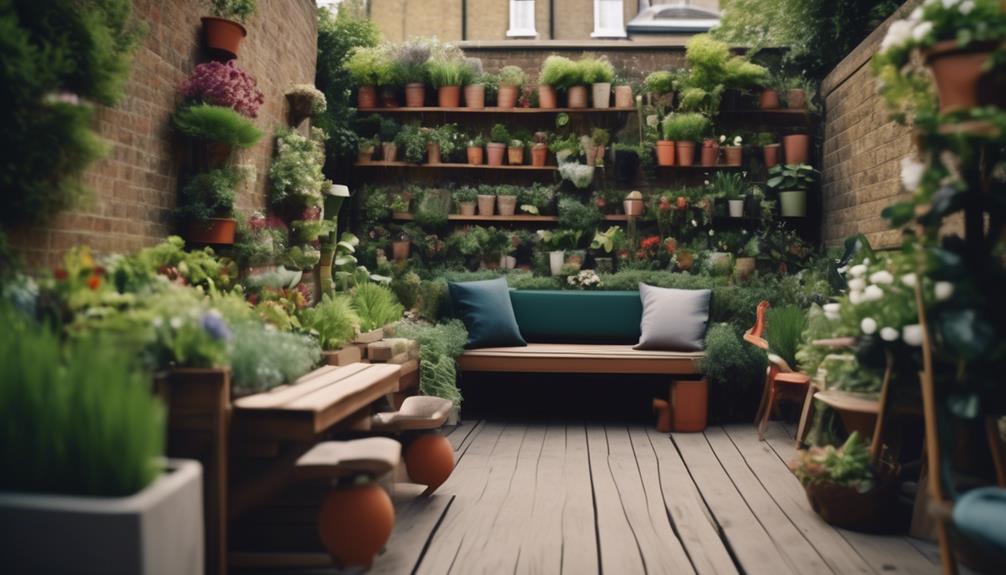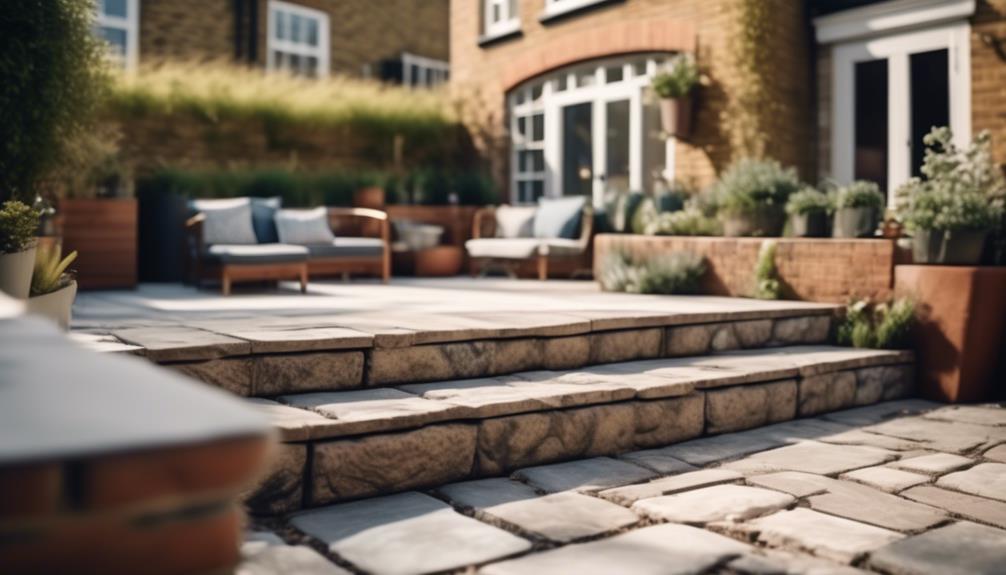Living in a city like London, where over 40% of the population resides in flats, finding ways to maximize balcony space for a thriving garden has become an art form.
Through trial and error, I’ve discovered some invaluable hacks for balcony gardening in this bustling metropolis. From choosing the right plants to weatherproofing solutions, there’s no shortage of creative ways to transform your balcony into a green oasis.
Join me as I share some practical tips and tricks that have turned my urban balcony into a flourishing garden retreat.
Key Takeaways
- Consider the local climate and specific conditions of your balcony space when choosing plants for balcony gardening in London.
- Maximize vertical space by utilizing wall-mounted planters or railing boxes to grow plants without overcrowding the space.
- Get creative with container gardening by repurposing old items like baskets, tin cans, or vintage teapots for unique hanging planters.
- Implement weatherproofing solutions such as applying a weather-resistant sealant to balcony flooring and investing in rainproof planters with drainage systems to protect plants from water damage.
Choosing the Right Plants
When selecting plants for balcony gardening in London, it’s essential to consider the local climate and the specific conditions of your balcony space. The first step is to assess your balcony layout. How much direct sunlight does it receive? Is it windy? Does it tend to stay damp?
For sunny, wind-exposed balconies, sturdy plants like lavender, rosemary, and succulents thrive. In shadier spots, consider ferns, hostas, or even certain types of ivy.
Once you understand your balcony’s unique microclimate, it’s time to think about plant selection. Opt for compact varieties that won’t overwhelm your space, such as dwarf fruit trees, compact herbs, or bushy flowers. Hanging baskets can be a great space-saving solution, allowing you to grow trailing plants like petunias or nasturtiums. Remember, vertical space is valuable, so consider using wall-mounted planters or railing boxes.
When choosing plants, think about not just their appearance, but also their scent and potential to attract pollinators. By carefully considering your balcony layout and plant selection, you can create a vibrant, green oasis in the heart of the city.
Maximizing Vertical Space
To maximize vertical space in balcony gardening, consider utilizing wall-mounted planters or railing boxes to efficiently grow a variety of plants without overcrowding the limited space. Hanging gardens are a great way to add greenery without sacrificing floor space. I’ve found that vertical planters are particularly effective for growing herbs, small vegetables, and trailing flowers. Here’s a practical way to make the most of your vertical space:
| Vertical Planter Type | Suitable Plants | Benefits |
|---|---|---|
| Wall-mounted planters | Herbs, succulents | Saves floor space, easy to water |
| Railing boxes | Small vegetables, trailing flowers | Utilizes railing space, adds privacy |
I’ve personally used both wall-mounted planters and railing boxes to create a lush and vibrant balcony garden. By carefully selecting the right planters and plants, you can maximize your vertical space and turn your balcony into a beautiful and functional green oasis.
Creative Container Gardening
Having successfully utilized wall-mounted planters and railing boxes to maximize vertical space in my balcony garden, I’ve found that creative container gardening offers an opportunity to further enhance the aesthetic appeal and functionality of the space.
DIY hanging planters have been a game-changer for me. By repurposing old baskets, tin cans, and even wooden crates, I’ve been able to create unique hanging planters that add a charming, rustic touch to my balcony. Upcycled containers, such as old mason jars or vintage teapots, have also proven to be excellent vessels for growing herbs and small flowers, adding a whimsical and eco-friendly element to my garden.
When it comes to creative container gardening, the key is to think outside the box – or in this case, the pot. I’ve experimented with unconventional items like old rain boots, broken teacups, and even a disused bicycle basket, and the results have been delightful. Not only does this approach add personality to my garden, but it also reduces waste by giving new life to items that would have otherwise been discarded.
Creative container gardening isn’t just about plants; it’s a way to infuse your balcony with character and sustainability.
Weatherproofing Solutions
As a seasoned balcony gardener in London, I’ve found that implementing weatherproofing solutions is essential to safeguarding the health and longevity of my plants amidst the unpredictable British climate.
One of the most effective DIY waterproofing solutions for balcony flooring is to apply a weather-resistant sealant. This helps to prevent water damage and extends the life of the balcony surface.
Additionally, investing in rainproof planters is crucial to protect the roots of plants from becoming waterlogged during heavy downpours. These specialized planters often come with drainage systems that help to regulate the water levels, keeping the soil adequately moist without drowning the plants.
Another essential weatherproofing solution is installing balcony awnings. These provide protection from both rain and excessive sun exposure, creating a more stable and comfortable environment for plants to thrive in. Awnings also shield the balcony floor from direct rainfall, reducing the risk of water seepage and damage.
Low-Maintenance Gardening Tips

Implementing low-maintenance gardening tips is a natural extension of my balcony weatherproofing efforts, ensuring that my plants continue to thrive without requiring constant attention and upkeep.
When it comes to watering techniques, I’ve found that investing in a self-watering system, such as planters with built-in reservoirs or drip irrigation, significantly reduces the frequency of manual watering. This not only saves time but also ensures that my plants receive consistent moisture, which is crucial for their overall health.
Additionally, using moisture-retentive soil mixes with added organic matter has been a game-changer for soil management. These soil blends help to improve water retention and reduce the frequency of watering, making them perfect for low-maintenance balcony gardening.
I’ve also incorporated slow-release fertilizers into the soil to provide essential nutrients to my plants over an extended period, minimizing the need for frequent fertilization.
Frequently Asked Questions
Can I Use Artificial Turf or Grass on My Balcony in London?
I’d recommend using artificial turf on my balcony in London. It’s a great grass alternative and adds a touch of nature to balcony decor. It’s perfect for small space landscaping and requires minimal maintenance.
What Are Some Balcony Gardening Tips Specifically for Dealing With London’s Pollution and Air Quality?
Dealing with London’s pollution and air quality on my balcony, I’ve found that air purifying plants like spider plants and peace lilies are essential. I also use vertical gardening techniques to maximize space and air purification.
Are There Any Specific Balcony Gardening Regulations or Restrictions in London That I Need to Be Aware Of?
I’ve found that London has specific balcony gardening restrictions, but there’s great community support and local resources to navigate them. It’s important to be aware of regulations and utilize available resources for a successful balcony garden.
How Can I Incorporate Sustainable Gardening Practices Into My Balcony Garden in London?
Incorporating sustainable balcony gardening in London is essential. Composting tips, urban gardening, and water conservation techniques can make a significant difference. I’ve found that using compost from kitchen scraps enriches the soil, and rainwater collection reduces water usage.
What Are Some Balcony Gardening Tips for Dealing With the Unique Weather Patterns in London, Such as Frequent Rain and Limited Sunlight?
Dealing with London’s unique weather patterns in balcony gardening requires rainwater collection and smart container gardening techniques. I’ve found that using self-watering containers and choosing plants that thrive in shade can make a big difference.
Conclusion
After years of balcony gardening in London, I’ve learned that choosing the right plants, maximizing vertical space, getting creative with containers, weatherproofing, and low-maintenance tips are essential for success.
By following these balcony gardening hacks, I’ve been able to create a lush and thriving garden in my limited outdoor space.
With a little creativity and practical know-how, anyone can enjoy a beautiful balcony garden in the heart of the city.

